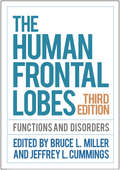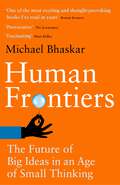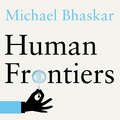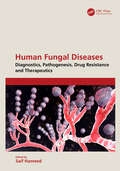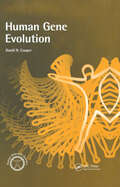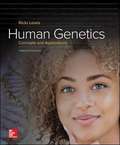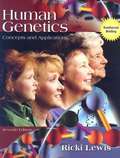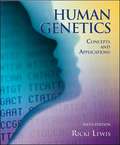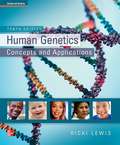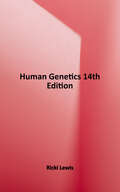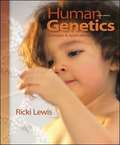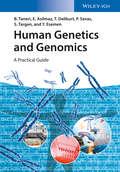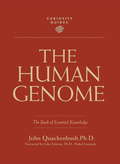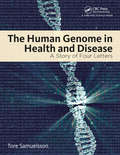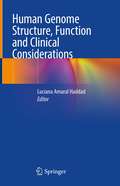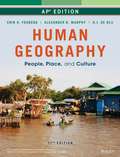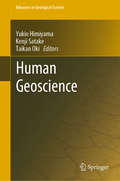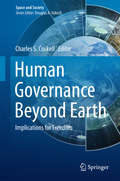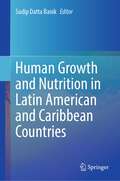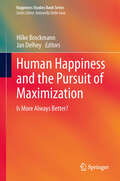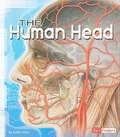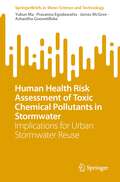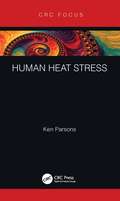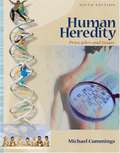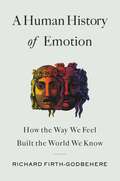- Table View
- List View
The Human Frontal Lobes, Third Edition: Functions and Disorders
by Bruce L. Miller Jeffrey L. CummingsThis authoritative work, now thoroughly revised, has given thousands of clinicians, students, and researchers a state-of-the-art understanding of the human frontal lobes--the large brain region that plays a critical role in behavior, cognition, health, and disease. Leading experts from multiple disciplines address the anatomy and chemistry of the frontal cortex, neuropsychological assessments of capabilities unique to the frontal lobes, the nature of (and possible treatment avenues for) frontotemporal dementia and related conditions, and implications for understanding and treating neuropsychiatric disorders, such as schizophrenia, mania, and depression. Illustrations include eight pages in full color. New to This Edition: *Reflects a decade of important research advances in such areas as functional connectivity mapping of frontal and frontal-subcortical circuits. *Incorporates significant new information on frontotemporal dementia and other neurological disorders. *Expanded section on neuropsychiatric disorders, with new chapters on apathy, dissociative states, and antisocial behavior. *Chapters on salience networks, normal brain aging, white matter diseases, and clinical trials. *Increased attention to brain processes involved in moral reasoning, empathy, decision making, and other key human capabilities.
Human Frontiers: The Future of Big Ideas in an Age of Small Thinking
by Michael Bhaskar'A fascinating, must-read book covering a vast array of topics from the arts to the sciences, technology to policy. This is a brilliant and thought-provoking response to one of the most critical questions of our age: how we will come up with the next generation of innovation and truly fresh ideas?'Mustafa Suleyman, cofounder of DeepMind and Google VP'Have "big ideas" and big social and economic changes disappeared from the scene? Michael Bhaskar's Human Frontiers is the best look at these all-important questions.'Tyler Cowen, author of The Great Stagnation and The Complacent Class'Michael Bhaskar explores the disturbing possibility that a complacent, cautious civilization has lost ambition and is slowly sinking into technological stagnation rather than accelerating into a magical future. He is calling for bold, adventurous innovators to go big again. A fascinating book'Matt Ridley, author of How Innovation WorksWhere next for humanity? Is our future one of endless improvement in all areas of life, from technology and travel to medicine, movies and music? Or are our best years behind us? It's easy to assume that the story of modern society is one of consistent, radical progress, but this is no longer true: more academics are researching than ever before but their work leads to fewer breakthroughs; innovation is incremental, limited to the digital sphere; the much-vaunted cure for cancer remains elusive; space travel has stalled since the heady era of the moonshot; politics is stuck in a rut, and the creative industries seem trapped in an ongoing cycle of rehashing genres and classics. The most ambitious ideas now struggle. Our great-great-great grandparents saw a series of transformative ideas revolutionise almost everything in just a few decades. Today, in contrast, short termism, risk aversion, and fractious decision making leaves the landscape timid and unimaginative.In Human Frontiers, Michael Bhaskar draws a vividly entertaining and expansive portrait of humanity's relationship with big ideas. He argues that stasis at the frontier is the result of having already pushed so far, taken easy wins and started to hit limits. But new thinking is still possible. By adopting bold global approaches, deploying cutting edge technology like AI and embracing a culture of change, we can push through and expand afresh.Perfect for anyone who has wondered why we haven't gone further, this book shows in fascinating detail how the 21st century could stall - or be the most revolutionary time in human history.
Human Frontiers: The Future of Big Ideas in an Age of Small Thinking
by Michael Bhaskar'A fascinating book . . . Bhaskar is a reassuringly positive and often witty guide'Observer'A fascinating, must-read book covering a vast array of topics from the arts to the sciences, technology to policy. This is a brilliant and thought-provoking response to one of the most critical questions of our age: how we will come up with the next generation of innovation and truly fresh ideas?'Mustafa Suleyman, cofounder of DeepMind and Google VP'Have "big ideas" and big social and economic changes disappeared from the scene? Michael Bhaskar's Human Frontiers is the best look at these all-important questions.'Tyler Cowen, author of The Great Stagnation and The Complacent Class'Michael Bhaskar explores the disturbing possibility that a complacent, cautious civilization has lost ambition and is slowly sinking into technological stagnation rather than accelerating into a magical future. He is calling for bold, adventurous innovators to go big again. A fascinating book'Matt Ridley, author of How Innovation WorksWhere next for humanity? Is our future one of endless improvement in all areas of life, from technology and travel to medicine, movies and music? Or are our best years behind us? It's easy to assume that the story of modern society is one of consistent, radical progress, but this is no longer true: more academics are researching than ever before but their work leads to fewer breakthroughs; innovation is incremental, limited to the digital sphere; the much-vaunted cure for cancer remains elusive; space travel has stalled since the heady era of the moonshot; politics is stuck in a rut, and the creative industries seem trapped in an ongoing cycle of rehashing genres and classics. The most ambitious ideas now struggle. Our great-great-great grandparents saw a series of transformative ideas revolutionise almost everything in just a few decades. Today, in contrast, short termism, risk aversion, and fractious decision making leaves the landscape timid and unimaginative.In Human Frontiers, Michael Bhaskar draws a vividly entertaining and expansive portrait of humanity's relationship with big ideas. He argues that stasis at the frontier is the result of having already pushed so far, taken easy wins and started to hit limits. But new thinking is still possible. By adopting bold global approaches, deploying cutting edge technology like AI and embracing a culture of change, we can push through and expand afresh.Perfect for anyone who has wondered why we haven't gone further, this book shows in fascinating detail how the 21st century could stall - or be the most revolutionary time in human history.
Human Fungal Diseases: Diagnostics, Pathogenesis, Drug Resistance and Therapeutics
by Saif HameedThis reference book reviews the latest advancements in the fungal infections and their impact on human health. It presents epidemiology, diagnosis, pathogenesis, risk factors, virulence mechanisms, treatment, and strategies for the disease management and prevention of fungal infections. The book further reviews host-pathogen interactions, biofilm formation, and quorum sensing. It also covers the clinical manifestations, diagnostic approaches, and management strategies of opportunistic fungal infections, emerging fungal infections, and allergic fungal infections. It presents the latest advancements in diagnostic methods and therapeutic strategies, covering both conventional techniques and state-of-the-art approaches.Further, the book elucidates antifungal stewardship, nanotechnology, and omics technologies, providing insights into cutting-edge strategies for prevention, control, and management of multidrug-resistant fungi. This book is useful for researchers, students, and health professionals working in the fields of mycology, infectious diseases, immunology, dermatology, and pulmonology.
Human Gene Evolution
by David CooperThe story of our evolutionary past is told in our genome sequence. Human Gene Evolution deals with the origins of human genes, describes their structure, function, organisation and expression. The text integrates our emerging knowledge of chromosome and genome structure, and discusses the nature of the mutational mechanisms underlying evolutionary change.
Human Genetics
by LewisToday, human genetics is for everyone. It is about variation more than about illnesses, and increasingly about the common rather than about the rare. Once an obscure science or an occasional explanation for an odd collection of symptoms, human genetics is now part of everyday conversation. By coming to know genetic backgrounds, people can control their environments in more healthy ways. Genetic knowledge is, therefore, both informative and empowering. This edition of Human Genetics: Concepts and Applications shows students how and why that is true
Human Genetics: Concepts and Applications (7th edition)
by Ricki LewisAn excellent introductory text for undergraduates, especially those with "sciencephobia." Slow-paced material incorporates information on genetics in the news, and features chapter outlines, real-life vignettes, technology timelines, key concepts, chapter glossaries, and review and applied questions, plus boxed readings on fun subjects like human werewolves, and color photos and diagrams. Includes sections on fundamentals, transmission genetics, DNA and chromosomes, population genetics, immunity and cancer, and the latest genetic technology. Annotation c. by Book News, Inc., Portland, Or.
Human Genetics: Concepts and Applications (6th edition)
by Ricki LewisAn excellent introductory text for undergraduates, especially those with "sciencephobia." Slow-paced material incorporates information on genetics in the news, and features chapter outlines, real-life vignettes, technology timelines, key concepts, chapter glossaries, and review and applied questions, plus boxed readings on fun subjects like human werewolves, and color photos and diagrams. Includes sections on fundamentals, transmission genetics, DNA and chromosomes, population genetics, immunity and cancer, and the latest genetic technology. Annotation c. by Book News, Inc., Portland, Or.
Human Genetics: Concepts and Applications
by Ricki LewisAn excellent introductory text for undergraduates, especially those with "sciencephobia. " Slow-paced material incorporates information on genetics in the news, and features chapter outlines, real-life vignettes, technology timelines, key concepts, chapter glossaries, and review and applied questions, plus boxed readings on fun subjects like human werewolves, and color photos and diagrams. Includes sections on fundamentals, transmission genetics, DNA and chromosomes, population genetics, immunity and cancer, and the latest genetic technology. Annotation c. by Book News, Inc. , Portland, Or.
Human Genetics: Concepts and Applications
by Ricki LewisHuman Genetics: Concepts and Applications embraces the broadening of human genetics from an academic and medical discipline to an informational science that can be highly personal, yet have a societal impact. By coming to know genetic backgrounds, people can control their environments in healthier ways. Genetic knowledge is, therefore, both informative and empowering.
Human Genetics: Concepts and Applications (Ninth Edition)
by Ricki LewisHuman Genetics: Concepts and Applications, ninth edition, is a non-science major's human genetics text that clearly explains what genes are, how they function, how they interact with the environment, and how our understanding of genetics has changed since completion of the human genome project. Meticulously updated, focused on concepts, and rich with personal stories from people whose lives are dramatically affected by the principles being discussed,Human Genetics is a textbook that will prepare the next generation of citizens for the decisions that lie ahead.
Human Genetics and Genomics: A Practical Guide
by Bahar Taneri Esra Asilmaz Türem Delikurt Pembe Savas Seniye Targen Yagmur EsemenFinally meeting the need for a laboratory manual on human genetics, this practical guide is the perfect companion title to all major standard textbooks on the subject. The authors all have a high-level research background and are actively involved in teaching and counseling. Based on a standard curriculum in human genetics, each chapter equals one practical unit of the course and topics range from basics in human inheritance to genetics in major disease clusters and from bioinformatics and personalized medicine to genetic counseling.
The Human Genome: The Book of Essential Knowledge
by John QuackenbushThe DNA sequence that comprises the human genome--the genetic blueprint found in each of our cells--is undoubtedly the greatest code ever to be broken. Completed at the dawn of a new millennium, the feat electrified both the scientific community and the general public with its tantalizing promise of new and better treatments for countless diseases, including Alzheimer's, cancer, diabetes, and Parkinson's. Yet what is arguably the most important discovery of our time has also opened a Pandora's box of questions about who we are as humans and how the unique information stored in our genomes can and might be used, making it all the more important for everyone to understand the new science of genomics. In the CURIOSITY GUIDE TO THE HUMAN GENOME, Dr. John Quackenbush, a renowned scientist and professor, conducts a fascinating tour of the history and science behind the Human Genome Project and the technologies that are revolutionizing the practice of medicine today. With a clear and engaging narrative style, he demystifies the fundamental principles of genetics and molecular biology, including the astounding ways in which genes function, alone or together with other genes and the environment, to either sustain life or trigger disease. In addition, Dr. Quackenbush goes beyond medicine to examine how DNA-sequencing technology is changing how we think of ourselves as a species by providing new insights about our earliest ancestors and reconfirming our inextricable link to all life on earth. Finally, he explores the legal and ethical questions surrounding such controversial topics as stem cell research, prenatal testing, forensics, and cloning, making this volume of the Curiosity Guides series an indispensable resource for navigating our brave new genomic world.
The Human Genome in Health and Disease: A Story of Four Letters
by Tore SamuelssonThe human genome is a linear sequence of roughly 3 billion bases and information regarding this genome is accumulating at an astonishing rate. Inspired by these advances, The Human Genome in Health and Disease: A Story of Four Letters explores the intimate link between sequence information and biological function. <P><P>A range of sequence-based functional units of the genome are discussed and illustrated with inherited disorders and cancer. In addition, the book considers valuable medical applications related to human genome sequencing, such as gene therapy methods and the identification of causative mutations in rare genetic disorders. <P><P>The primary audiences of the book are students of genetics, biology, medicine, molecular biology and bioinformatics. Richly illustrated with review questions provided for each chapter, the book helps students without previous studies of genetics and molecular biology. It may also be of benefit for advanced non-academics, which in the era of personal genomics, want to learn more about their genome. <P><P> Key selling features: <P><P>Molecular sequence perspective, explaining the relationship between DNA sequence motifs and biological function <P><P>Aids in understanding the functional impact of mutations and genetic variants <P><P>Material presented at basic level, making it accessible to students without previous studies of genetics and molecular biology <P><P>Richly illustrated with questions provided to each chapter
Human Genome Structure, Function and Clinical Considerations
by Luciana Amaral HaddadThis book provides a detailed evidence-based overview of the latest developments in how the structure of the human genome is relevant to the health professional. It features comprehensive reviews of genome science including human chromosomal and mitochondrial DNA structure, protein-coding and noncoding genes, and the diverse classes of repeat elements of the human genome. These concepts are then built upon to provide context as to how they functionally relate to differences in phenotypic traits that can be observed in human populations. Guidance is also provided on how this information can be applied by the medical practitioner in day-to-day clinical practice. Human Genome Structure, Function and Clinical Considerations collates the latest developments in genome science and current methods for genome analysis that are relevant for the clinician, researcher and scientist who utilises precision medicine techniques and is an essential resource for any such practitioner.
Human Geography: People Place and Culture (11th AP edition)
by Erin H. Fouberg Alexander B. Murphy H.J. de BlijOur goals in writing the Eleventh Edition of Human Geography: People, Place, and Culture were, first, to help students appreciate the diversity of the planet and the role people play in shaping that diversity; second, to provide context for the issues we address so that students can better understand their world; third, to give students the tools to grapple with the complexities of globalization; and fourth, to help students think geographically and critically about their world.
Human Geoscience (Advances in Geological Science)
by Yukio Himiyama Kenji Satake Taikan OkiThis book is a product of the joint efforts of interdisciplinary academic fields under the integrative framework of human geoscience. Human geoscience is a new genre of geoscience concerned with the natural phenomena that occur on the surface of the Earth and their relations with human activities. It therefore has connections with many fields of geoscience, namely, physical geography, geomorphology, geology, soil science, sedimentology, seismology, volcanology, meteorology, climatology, oceanography, and hydrology. It also has strong links to the humanities, social sciences, agricultural sciences, and engineering related to disaster prevention or mitigation. All these disciplines are important fields for understanding disasters and global environmental problems and for evaluating the associated risks comprehensively, then proposing mitigation strategies.The volume is designed for those who may not necessarily have a geoscience background but have broad scientific interest in understanding the causes, mechanisms, and consequences of geo-disasters and global environmental problems and wish to make the world more sustainable on that basis. The book consists of six parts: I. Introduction, II. Earth Surface Realms, III. Natural Resources and Society, IV. Natural Hazards and Society, V. Global Environmental Problems, and VI. Global Sustainability Programmes and Human Geoscience, which discusses the contribution of this field of science to a new comprehensive framework for global sustainability.
Human Governance Beyond Earth
by Charles S. CockellThis book extends the discussion of the nature of freedom and what it means for a human to be free. This question has occupied the minds of thinkers since the Enlightenment. However, without exception, every one of these discussions has focused on the character of liberty on Earth. In this volume the authors explore how people are likely to be governed in space and how that will affect what sort of liberty they experience. Who will control oxygen? How will people maximise freedom of movement in a lethal environment? What sort of political and economic systems can be created in places that will be inherently isolated? These are just a few of the major questions that bear on the topic of extra-terrestrial liberty. During the last forty years an increasing number of nations have developed the capability of launching people into space. The USA, Europe, Russia, China and soon India have human space exploration programs. These developments raise the fundamental question of how are humans to be governed in space. This book follows from a previous volume published in this series which looked at the Meaning of Liberty Beyond the Earth and explored what sort of freedoms could exist in space in a very general way. This new volume focuses on systems of governance and how they will influence which of these sorts of freedoms will become dominant in extra-terrestrial society. The book targets a wide readership covers many groups including: Space policy makers interested in understanding how societies will develop in space and what the policy implications might be for space organisations. Space engineers interested in understanding how social developments in space might influence the way in which infrastructure and space settlements should be designed. Space scientists interested in how scientific developments might influence the social structures of settlements beyond the Earth. Social scientists (political philosophers, ethicists etc) interested in understanding how societies will develop in the future.
Human Growth and Nutrition in Latin American and Caribbean Countries
by Sudip Datta BanikThis book analyzes biological and sociocultural factors that influence nutritional status, physical growth, development and maturation of children and adolescents in Latin American and Caribbean (LAC) countries in the perspective of human ecology. Chapters in this book bring together both theoretical and empirical studies that take into account human biological and environmental conditions to understand how ethnic diversity, culturally determined lifestyle and dietary habits influence biological variation of human growth and nutrition in nine LAC countries: Argentina, Brazil, Chile, Cuba, Dominican Republic, El Salvador, Guatemala, Mexico, and Peru. The book is divided into three sections. Chapters in the first section analyze nutritional and epidemiological aspects of child growth in the region. Articles in the second section focus on methods to evaluate human growth, development, and maturation. Finally, the third section brings together a series of studies representing different LAC countries, analyzing biocultural impacts on child growth and nutrition. By bringing together studies about the relationship between human biology, cultural diversity, nutrition and health in a region with huge environmental challenges, this volume addresses many of the challenges to achieve the United Nation’s Sustainable Development Goals 2 (Zero Hunger) and 3 (Good Health and Well-Being). Chapters in this volume present and discuss data on the effects of malnutrition on children's and adolescent's health and development, such as chronic undernutrition or stunting (growth deficit) and excess weight (overweight and obesity) as the risk factors for child morbidity and mortality m due to non-communicable diseases. Human Growth and Nutrition in Latin American and Caribbean Countries will be a valuable resource for both students and researchers in different disciplines dedicated to the interdisciplinary research on the intersection between human biology, cultural diversity, nutrition and health. It will also be a useful source of information for both health professionals and policy makers developing and implementing interventions and public policies to achieve UN’s SDGs 2 and 3, particularly in the LAC regions.
Human Happiness and the Pursuit of Maximization: Is More Always Better?
by Hilke Brockmann Jan DelheyThis book tests the critical potential of happiness research to evaluate contemporary high-performance societies. These societies, defined as affluent capitalist societies, emphasize competition and success both institutionally and culturally. Growing affluence improves life in many ways, for a large number of people. We lead longer, safer, and more comfortable lives than previous generations. But we also live faster, and are competition-toughened, like top athletes. As a result, we suspect limits and detect downsides of our high-speed lives. The ubiquitous maximization principle opens up a systematic gateway to the pleasures and pains of contemporary life. Using happiness as a reference point, this book explores the philosophical and empirical limits of the maximization rule. It considers the answer to questions such as: Precisely, why did the idea of (economic) maximization gain so much ground in our Western way of thinking? When, and in which life domains, does maximization work, when does it fail? When do qualities and when do quantities matter? Does maximization yield a different (un)happiness dividend in different species, cultures, and societies?
The Human Head
by Kathy Allen Jenny KruegerEyes, nose, mouth you can see what's on your head. But do you know what goes on under the surface? Explore the layers of the human head to find out what really goes on behind your smile.
Human Health Risk Assessment of Toxic Chemical Pollutants in Stormwater: Implications for Urban Stormwater Reuse (SpringerBriefs in Water Science and Technology)
by Yukun Ma Prasanna Egodawatta James McGree Ashantha GoonetillekeThis book presents a detailed analysis in relation to human health risk assessment of the main toxic chemical pollutants in urban stormwater generated from urban traffic and land use activities. The knowledge presented in this book was derived based on comprehensive experimental investigations including field sampling, laboratory testing, mathematical modelling, spatial analysis and multivariate and univariate statistical data analyses. The key highlights of the book include the quantitative assessment of the human health risk posed by key toxic chemical pollutants in urban stormwater and the development of linkages between risk and traffic and land use. Additionally, a suite of mathematical equations are presented to predict human health risk based on traffic and land use characteristics through mathematical modelling. These outcomes can significantly assist in effective stormwater risk management under changing traffic and land use in the urban environment. The knowledge presented is of particular interest to readers such as stormwater treatment design specialists, decision-makers and urban planners since these outcomes provide practical suggestions and recommendations for effective urban stormwater treatment design.
Human Heat Stress
by Ken ParsonsThousands of people continue to die from heat. Heat illnesses and advice for preventing heat casualties at work, during heatwaves, sport and the effects of global warming are described. A new perspective on thermoregulation integrates physiological and psychophysical regulated variables. Heat stress indices, the WBGT and the SWreq are presented. It is time to understand and routinely use computer simulations of people in hot conditions. How to understand how a model can be constructed is also described. This book provides an accessible, concise and comprehensive coverage into how people respond to heat and how to predict and avoid heat causalities. A practical productivity model, and Burn thresholds, complete the book which begins with up to date knowledge on measurement of heat stress, heat strain, metabolic rate and the thermal properties and influences of clothing. Features Provides methods and regulations through international standards Illustrates the WBGT and analytical heat stress indices and how to construct a thermal model Discusses the role of clothing on heat stress and thermal strain Presents a new model for predicting productivity in the heat Offers a new method of human thermoregulation Considers heat illness and prevention during heatwaves and in global warming
Human Heredity: Principles And Issues (Sixth Edition)
by Michael R. CummingsThis edition of Human Heredity is being published at a time of transition in the field of human genetics, shortly after the draft sequence of the human genome was published. Two landmark papers published in 2001, one in Science and the other in Nature, give us a glimpse into the size, organization, and evolutionary history of our genome.
A Human History of Emotion: How the Way We Feel Built the World We Know
by Richard Firth-GodbehereA sweeping exploration of the ways in which emotions shaped the course of human history, and how our experience and understanding of emotions have evolved along with us. "Eye-opening and thought-provoking!&” (Gina Rippon, author of The Gendered Brain) We humans like to think of ourselves as rational creatures, who, as a species, have relied on calculation and intellect to survive. But many of the most important moments in our history had little to do with cold, hard facts and a lot to do with feelings. Events ranging from the origins of philosophy to the birth of the world&’s major religions, the fall of Rome, the Scientific Revolution, and some of the bloodiest wars that humanity has ever experienced can&’t be properly understood without understanding emotions.Drawing on psychology, neuroscience, philosophy, art, and religious history, Richard Firth-Godbehere takes readers on a fascinating and wide ranging tour of the central and often under-appreciated role emotions have played in human societies around the world and throughout history—from Ancient Greece to Gambia, Japan, the Ottoman Empire, the United States, and beyond. A Human History of Emotion vividly illustrates how our understanding and experience of emotions has changed over time, and how our beliefs about feelings—and our feelings themselves—profoundly shaped us and the world we inhabit.
